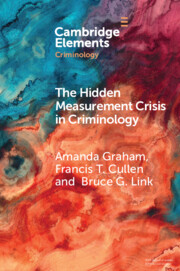Element contents
The Hidden Measurement Crisis in Criminology
Published online by Cambridge University Press: 03 March 2025
Summary
- Type
- Element
- Information
- Series: Elements in CriminologyOnline ISBN: 9781009558549Publisher: Cambridge University PressPrint publication: 27 March 2025
References
- 2
- Cited by

